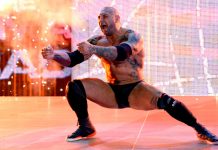This week’s edition of The VHS Memoirs will look at Living Dangerously 2000, and aside from the opening bout, one of the reasons that I picked this particular event for this review is that you can more or less pinpoint this pay-per-view as the start to when the wheels begin to unhinge for the company that was building momentum up until that point. More so than the card itself, which had a few bright spots, but mostly average bouts, Living Dangerously encapsulates why the organization had such a drastic decline as a business entity. To put it in perspective, it’s important to note that this was a time frame when the company really saw the pressure of the competition of the industry impact its ability to remain a commodity. As we know, the previous year, the group saw Taz, it’s perennial champion, and The Dudleys, the tag team that was the foundation of the division, leave within the span of just a few weeks for better money in the WWF. Shane Douglas, quite literally the franchise player for the organization in its early years, left for a solid payday in WCW. There were other departures in the past, but it seemed there was almost a rotating basis and it was more individual exits than multiple talents within a relatively short time.
For example, Raven originally left in 1997, but guys like Mike Awesome and Masato Tanaka were added into the mix the following year to help add depth to the roster. Speaking of Awesome, he left the company just a month after this pay-per-view with the controversial jump to WCW to attack Kevin Nash on Nitro while he was still the ECW Heavyweight champion. At the time, Awesome was vilified for not dropping the championship, but I think since then, the perspective on his exit became more much understandable with the expansion of the internet to allow for the other side of the story to be told. On one hand, some will paint Paul Heyman as a conman that got his wrestlers to do ridiculous stunts for little to no money, and on the other hand, some will overlook the flaws to cite his wrestling genius. In truth, Heyman was probably a desperate businessman that was trying to keep his company afloat, which doesn’t excuse the stories of bounced checks, but at the same time, the situation isn’t as sinister as some would claim either. That said, you can’t really blame Mike Awesome for leaving when he did, especially in retrospect. Mike Awesome was the heavyweight champion of a national wrestling company, was featured on a video game, and had an action figure, but wasn’t getting paid. He couldn’t tell the mortgage company, “don’t worry, Paul E said the check is in the mail.”
That’s ultimately why this show is such a key part of the history of ECW because it essentially exposed a lack of star power, despite a talented roster, and eventually the inability to keep pace with the pay scale of the industry at the time. Keep in mind, the WWF and WCW had an all hands on deck approach to the Monday night war, and talent became a premium commodity that the big leagues were willing to pay big money to in an attempt to either maintain or achieve a lead in the ratings war. Granted, Mike Awesome’s potential was wasted because Vince Russo decided to book him as a comedy character, and Shane Douglas didn’t achieve bigger fame in WCW in 2000, but the point being those guys were among the talent that were offered big money to attempt to add depth to the roster on Nitro to try to keep pace with Raw. Extreme Championship Wrestling always ran so close to the edge, both with its finances and its presentation that it just didn’t have the revenue to retain the stars it made before they had to take the contract from the bigger organizations.
A side note, the now-defunct Acclaim video game company was the featured sponsor of the broadcast with its release of ECW Hardcore Revolution the month prior. One of the reasons that the video game and Acclaim specifically were heavily-promoted throughout the pay-per-view was that Paul Heyman, in a desperate attempt to generate another revenue stream to keep pace with the previously mentioned pressure of the industry, divided up slices of ECW in exchange for the production of the video game, and later for DVD releases through the short-lived Pioneer Entertainment group. This is why both Acclaim and Pioneer had claims during the bankruptcy process, and also why it took more than a year for the WWE to buy the rights to the trademarks.
The show opened with a really great monologue by The Sinister Minister, which was before he worked as the manager for the team of Tajiri and Mikey Whipreck later that year. I’ve said it before, but I must say it again, Jim Mitchell was probably the most underrated manager in the history of the business. If I had to guess, the fact that he was stuck in WCW purgatory when the blood runs cold angle became a secondary storyline and disappeared from television for almost two years while still under contract kept him from getting bigger exposure when the industry was at a peak in the late-90s. Sure, he did good work in ECW, too but by the time he got there in 2000, the company was on shaky ground before it folded so again, his exposure was limited. As we know, he did stellar work alongside Abyss in TNA, but even there, he was used sporadically. However, make no mistake about it, Jim Mitchell was a true talent that didn’t get the credit he deserved.
Steve Corino did an in-ring promo and mocked Lori Fultington, The Sandman’s wife, at ringside. She was brought into the ring and eventually gored through a table by Rhino. The Sandman attempted to make the save, but was also gored. The storyline saw The Sandman go to the hospital with his wife so he forfeited his match against Rhino in the ECW TV title tournament, which was booked after a broken leg forced Rob Van Dam to vacate the championship. I get that the angle was to get heat for Rhino as the network’s chosen champion and thus an easier road to the finals, but I’m not sure how wise it was not to put The Sandman, one of the company’s biggest stars in a match on pay-per-view, especially at a time when there was declining star power in the organization.
The wild segment brings Dusty Rhodes to the ring to start the scheduled bull rope match against Corino. This was one of the benefits of such a flourishing industry at the time, Dusty had a short strife with WCW so he took a detour to ECW for a few months before he returned to the Turner organization in April. Still, just those few months of Dusty in ECW were key to Corino becoming a star in the group’s latter stage. The match itself was basic, but entertaining. Corino and Dusty were bloody, and this had somewhat of an old school NWA presentation to it, especially when Corino was bleeding from the arm after the American Dream raked the bell across his bicep. In some ways, there bout was Corino earning his stripes for the ECW audience. There was a brawl through the crowd before Rhodes hit the bionic elbow for the victory. It should be noted that despite being older, Dusty could still perform and had the crowd following the action.
CW Anderson and Billy Wiles beat Danny Doring and Roadkill. There wasn’t anything wrong with this, but it was a basic tag match that went about six minutes before Elektra turned on Doring and Road Kill, joining The New Dangerous Alliance to assist them to get the win.
Next, Simon Diamond did a promo before Kid Kash cut him off and then they were interrupted by Mike Awesome, who was in a tag title match later that night. As the ECW champion, Awesome made a challenge that was accepted by Kash. This was basically a three-minute squash match that showcased Awesome as a monster when he power bombed Kash from the top rope through a table to get a three count. Other than to shoehorn a few more performers on the pay-per-view, I don’t know why Simon Diamond did a promo to start the segment.
Jazz was checking on Kash before she was attacked by Simon Diamond, who was joined by Jado and Gedo from FMW, which saw the start of an impromptu bout where Nova and Chris Chetti defeated Jado and Gedo in about five minutes. I understand why Jado and Gedo were on the card because of the FMW working agreement with Tanaka and Kanemura also at the show, but very similar to the other tag match earlier in the night, this contest was just a basic tag match. It only went a few minutes and wasn’t something that you would consider PPV quality.
In the other semi-final match of the ECW TV title tournament, Super Crazy pinned Little Guido after a somewhat botched finish. It looked like the ref counted three and was going to call for the end of the bout, which Joey Styles acknowledged on commentary, but Guido kicked out. It appeared that Crazy and Guido wanted to make sure they got the last spot of a brain buster through what was left of a table before the conclusion of the contest. Other than that, this was more or less what was already seen during the previous Super Crazy/ Little Guido bouts, which isn’t meant as a negative. There was crisp, fast-paced wrestling and it was an entertaining match.
Balls Mahoney beat Kanemura in about two minutes so other than a few stiff chair shots, there’s not much to discuss. Da Baldies did a run-in to attack Mahoney, and that set up for New Jack to make his way to the ring. After a short brawl, Vic Grimes and New Jack climbed the scaffold for the infamous Danbury fall. Grimes hesitated when going off the scaffold and thus landed on top of New Jack’s head on the floor. Truthfully, despite a fractured skull, I’m honestly surprised that New Jack didn’t suffer career-ending injuries from this spot. This whole thing was really a disaster as the scaffold had small beams so even trying to set up for the spot was difficult and the actual fall was poorly planned even if it would’ve went smoothly at the pay-per-view. If I had to guess, this was a situation where ECW tried to push the envelope on pay-per-view in an attempt to substitute for the lack of star power on the card.
The infamous New Jack/Vic Grimes fall from Living Dangerously 2000 pic.twitter.com/2Jl756HjLr
— The Extreme Collector (@extremecollect) March 26, 2020
The Impact Players won a tag title three-way dance to win the belts. There was rather odd booking because Mike Awesome and Raven were the champions. Tommy Dreamer and Tanaka were both over baby faces, but the team itself was short-lived. Raven took the pin just a few minutes into the contest for his team to get eliminated. The bout had some good action, but only went about eight minutes before The Impact Players used a spike pile driver to pin Dreamer to get the win. There match was too short to really get into second gear for the pay-per-view.
Speaking of eight minutes, that’s roughly what the main event got when Super Crazy beat Rhino to win the ECW TV belt. The Sandman and the injured Rob Van Dam were involved in the bout. Super Crazy won the title after a moonsault, but this wasn’t a main event level match. Super Crazy was popular in ECW, but I don’t think he was at the level to headline a pay-per-view at this point. The run-ins made the match itself somewhat clunky and the conclusion was rather flat. Overall, this pay-per-view had two really solid matches, and the infamous Danbury fall, but outside of that it was a show that appeared to be thrown together without a lot of direction for the product.
What do you think? Share your thoughts, opinions, feedback, and anything else that was raised on Twitter @PWMania and Facebook.com/PWMania.
Until next week
-Jim LaMotta
E mail [email protected] | You can follow me on Twitter @jimlamotta







